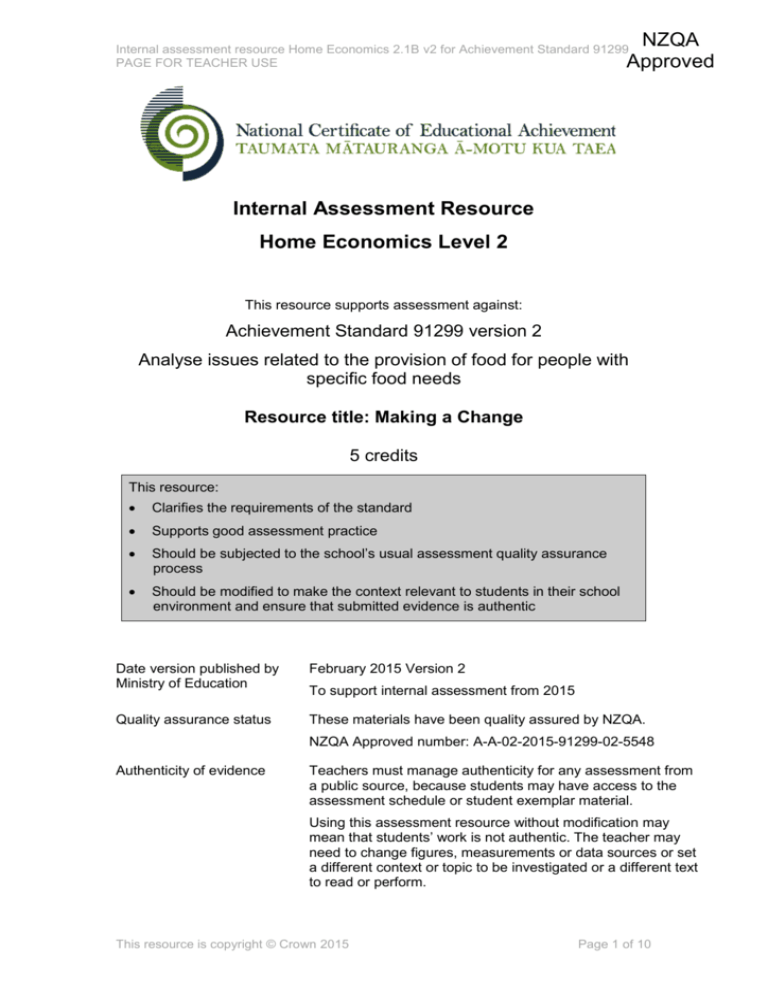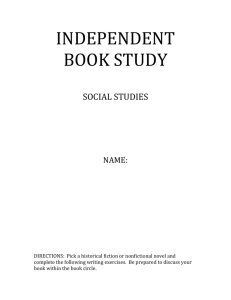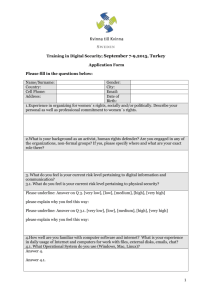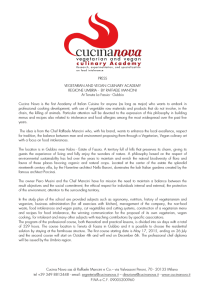homeec2_1B_v2_feb15
advertisement

NZQA Approved Internal assessment resource Home Economics 2.1B v2 for Achievement Standard 91299 PAGE FOR TEACHER USE Internal Assessment Resource Home Economics Level 2 This resource supports assessment against: Achievement Standard 91299 version 2 Analyse issues related to the provision of food for people with specific food needs Resource title: Making a Change 5 credits This resource: Clarifies the requirements of the standard Supports good assessment practice Should be subjected to the school’s usual assessment quality assurance process Should be modified to make the context relevant to students in their school environment and ensure that submitted evidence is authentic Date version published by Ministry of Education February 2015 Version 2 Quality assurance status These materials have been quality assured by NZQA. To support internal assessment from 2015 NZQA Approved number: A-A-02-2015-91299-02-5548 Authenticity of evidence Teachers must manage authenticity for any assessment from a public source, because students may have access to the assessment schedule or student exemplar material. Using this assessment resource without modification may mean that students’ work is not authentic. The teacher may need to change figures, measurements or data sources or set a different context or topic to be investigated or a different text to read or perform. This resource is copyright © Crown 2015 Page 1 of 10 Internal assessment resource Home Economics 2.1B v2 for Achievement Standard 91299 PAGE FOR TEACHER USE Internal Assessment Resource Achievement Standard Home Economics 91299: Analyse issues related to the provision of food for people with specific food needs Resource reference: Home Economics 2.1B v2 Resource title: Making a Change Credits: 5 Teacher guidelines The following guidelines are supplied to enable teachers to carry out valid and consistent assessment using this internal assessment resource. Teachers need to be very familiar with the outcome being assessed by Achievement Standard Home Economics 91299. The achievement criteria and the explanatory notes contain information, definitions, and requirements that are crucial when interpreting the standard and assessing students against it. Context/setting This assessment activity requires students to analyse specific food needs from personal, interpersonal, and societal perspectives and to consider health enhancing strategies to address these issues. Teacher note: At the beginning of this unit of study, negotiate a specific food need that is of particular interest to your students to study as preparation for this assessment activity. For example, toddlers, vegans, high-energy users, pregnant women, or people with food allergies. Students are expected to undertake a detailed analysis. They will be assessed on the depth and comprehensiveness of the discussion in their final report or presentation. Prior to beginning this assessment activity, provide students with opportunities to explore the following to ensure they have the knowledge and skills to complete the assessment activity. Students should: explore the personal issues or nutritional requirements of the people with specific food needs investigate interpersonal and societal issues which affect the provision of food for these people with specific food needs investigate and practise a wide range of preparation and cooking skills using foods suitable for the people with specific food needs. explore a range of health enhancing strategies to address personal, interpersonal and societal issues become familiar with the relevant Food and Nutrition Guidelines http://www.moh.govt.nz/moh.nsf/indexmh/nutrition-foodandnutritionguidelines develop their understanding of the socio-ecological perspective. The following This resource is copyright © Crown 2015 Page 2 of 10 Internal assessment resource Home Economics 2.1B v2 for Achievement Standard 91299 PAGE FOR TEACHER USE resources may be useful: Health and Physical Education Curriculum (1999), p.33, available at www.tki.org.nz/r/health/curriculum/statement/ Making Meaning: Making a Difference (2004), available at www.tki.org.nz/r/health/cia/make_meaning/index_e.php. Conditions Students may conduct research as a class, in a small group, or individually, but they will write their report or presentation individually. It is suggested that students have at least 40 hours of teaching and learning on the specific food needs of the focus group before completing this assessment activity. It is suggested that students have at least 10 hours of in and out-of-class time to complete this assessment activity. Adjust this time frame to suit the needs of your students. Resource requirements Students will require access to: relevant Food and Nutrition Guidelines (www.moh.govt.nz/foodandnutrition) Internet and library access for research presentation software and equipment. Additional information The action competence learning process may be useful as a learning tool to support student achievement. Information can be found in Making Meaning: Making a Difference (2004) at http://toolselector.tki.org.nz/r/health/cia/make_meaning/teach_learnappr_proc_e.php. The TKI Software for Learning website (http://softwareforlearning.tki.org.nz) is a good source of information about selecting and using suitable software for articles, presentations, and other formats. This resource is copyright © Crown 2015 Page 3 of 10 Internal assessment resource Home Economics 2.1B v2 for Achievement Standard 91299 PAGE FOR STUDENT USE Internal Assessment Resource Achievement Standard Home Economics 91299: Analyse issues related to the provision of food for people with specific food needs Resource reference: Home Economics 2.1B v2 Resource title: Making a Change Credits: 5 Achievement Analyse issues related to the provision of food for people with specific food needs. Achievement with Merit Analyse issues in depth related to the provision of food for people with specific food needs. Achievement with Excellence Comprehensively analyse issues related to the provision of food for people with specific food needs. Student instructions Introduction This assessment activity requires you to analyse specific food needs from personal, interpersonal, and societal perspectives and to consider health enhancing strategies to address these issues. You will do this by: creating a scenario that includes real or fictional people who have specific food needs Teacher note: Provide a scenario or negotiate the development of one with the students. Ensure the case study includes a variety of issues from a personal, interpersonal and societal perspective. conducting research to further investigate the personal, interpersonal, and societal issues related to the provision of food for these people proposing and justifying strategies to address these issues presenting your findings in a format agreed with your teacher, for example, a written report or presentation. You will be assessed on the depth and comprehensiveness of the discussion in your final report or presentation. You may conduct research as a class, in a small group, or individually, but you will create your report or presentation individually. Teacher note: Select or negotiate a final report format to meet the identified needs of your students. You have X weeks of in and out-of-class time to complete this assessment activity. Teacher note: Adapt the time allowed to meet the identified needs of your students. This resource is copyright © Crown 2015 Page 4 of 10 Internal assessment resource Home Economics 2.1B v2 for Achievement Standard 91299 PAGE FOR STUDENT USE Task Write a scenario Write a detailed scenario about real or fictional people with specific food needs (or a family with a person with the specific food need). Possible scenarios could include, but are not limited to: a family with a vegan lifestyle teenage athletes who wants to improve their sports performance teachers at the local kindergarten who want the pre-schoolers to prepare and share nutritious snacks people with coeliac disease a family with a child who has a peanut allergy. Teacher note: If students intend to conduct interviews to write the scenario, provide guidance on how to use ethical research procedures to preserve their interviewee’s anonymity. Include information about the peoples’ dietary habits, specific food needs, and lifestyle, as appropriate. Your scenario needs to be of sufficient complexity to allow you to conduct an in-depth investigation. (See Resource A for examples of information to include in your scenario and Resource B for a possible scenario.) Confirm the appropriateness of your scenario with your teacher. Teacher note: Confirm that the scenario has sufficient personal detail to allow students to comprehensively analyse the selected or fictional people’s personal needs and related interpersonal and societal issues. Write your report Write a report or presentation in which you analyse issues related to the provision of food for the people in your scenario. Your report should be based on research and will be relevant to the people with the specific needs. Confirm the format of your report with your teacher. For example, it could be a written report or a presentation. Your report should include: the scenario describing the people with specific food needs. the various issues relating to the provision of food from a personal, interpersonal, and societal perspective. See Resources A, B, and C for more information. a range of health-enhancing strategies to address these issues. Personal - a wide range of suitable food and liquid choices, or a weeklong meal plan or menu. Interpersonal - strategies that will make it easier for the people with specific food needs and their families to select, prepare, and cook meals. Societal - strategies that may help the people with specific food needs to address food choices in a wider community or social setting. an explanation of how and why the strategies will help the people to meet their specific food needs from a personal perspective. For example, explain why you have chosen these particular foods and drinks. Make connections to key nutrients and their functions related to the specific needs of the group. This resource is copyright © Crown 2015 Page 5 of 10 Internal assessment resource Home Economics 2.1B v2 for Achievement Standard 91299 PAGE FOR STUDENT USE an explanation of how and why the strategies will help the people to address the interpersonal, and societal issues. For example, explain what the person and their family, friends, and others can do to make these strategies more successful. Give reasons to support your answers. a justification that highlights the effectiveness of the strategies by explaining the connections to the personal, interpersonal and societal issues. a reference list that acknowledges books, Internet sites, and other sources used to create your report. Remember to relate your report to the people with specific food needs and their issues that need to be addressed. Submit your report or presentation to your teacher for assessment. This resource is copyright © Crown 2015 Page 6 of 10 Internal assessment resource Home Economics 2.1B v2 for Achievement Standard 91299 PAGE FOR STUDENT USE Resource A: Suggested information to include in your scenario When creating your scenario, you may like to consider the person’s: age and gender of the group specific food needs, for example, vegan, or pregnant existing diet, for example, their food and water intake, the frequency and regularity of their mealtimes and snacks, how often they eat takeaways lifestyle, for example, their level of physical activity, their involvement in food planning and preparation, access to food sources social situation, for example, their connections to family and friends, their culture, their hobbies food preferences knowledge about nutrition and the level of their cooking skills food budget. Resource B: Sample scenario The Smith family: new vegans The Smith family has recently begun to follow a vegan way of life as a result of a growing interest in vegan practices introduced to them by their teenage daughter, Katie. They plan to avoid all meat, poultry, fish, eggs, and dairy products. They will initially continue to include honey in their diet. The family consists of Mr and Mrs Smith, both of whom work full-time, and their two teenage children: Brent, 13 years old and in year 9, Katie, 16 years old and in Year 12. All four Smiths are physically active, with no health issues. The family belongs to a tramping club and frequently spends weekends hiking in the mountains. Both teenagers play hockey at school and are trying out for representative teams. Katie and her father have established a good vegetable garden. Extended family members have a variety of fruit trees. Both parents enjoy cooking a variety of ethnic foods. However, they have little time to cook, especially during the week, and a limited food budget. The parents would like the children to develop their cooking skills. Everyone in the family eats dinner together. They usually make their own lunches for work and school since it is difficult to find vegan food to buy. Katie sometimes skips breakfast and often has only fruit during the school day. The family believes that eating a vegan diet is healthy, but no one has a good understanding of what a healthy vegan diet would look like for active adults and teens. Tramping food is a challenge, since pre-prepared foods are rarely vegan, while the shared lunches and dinners that are a regular part of the tramping and hockey scenes often leave the Smiths hungry. This resource is copyright © Crown 2015 Page 7 of 10 Internal assessment resource Home Economics 2.1B v2 for Achievement Standard 91299 PAGE FOR STUDENT USE Resource C: Issues to consider Issues that could affect the people/person with specific food needs could include, but are not limited to: cost and availability of food nutritional knowledge and access to credible information food selection and preparation skills food safety palatability timing of meal occasions. When determining the personal, interpersonal, and societal issues related to people with specific food needs, possible considerations could include: What specific nutrients and fluids do the people require? How do factors such as exercise habits, culture, and social life affect the peoples’ food choices? What information is available to help the group or the family to select and prepare food that meets their nutritional needs? How can the family minimise their food costs while providing adequate nutrition for the people with specific food needs? How can the people schedule their meals and snacks around their other commitments? How can the people help themselves to make good food choices in a social situation? This resource is copyright © Crown 2015 Page 8 of 10 Internal assessment resource Home Economics 2.1B v2 for Achievement Standard 91299 PAGE FOR TEACHER USE Assessment schedule: Home Economics 91299 Making a Change Evidence/Judgements for Achievement Evidence/Judgements for Achievement with Merit The student has analysed issues related to the provision of food for people with specific food needs. The student has analysed in-depth issues related to the provision of food for people with specific food needs. The student has comprehensively analysed issues related to the provision of food for people with specific food needs. The student has: The student has given reasons linked to performance enhancement for the strategies used to address the issues. The student has justified the connections between the personal, interpersonal, and societal issues used. For example: For example: As a family, the Smiths can come up with a weekly menu that suits their likes and dislikes and ensures that they get the nutrients required. To reduce food costs, they can make sure that this menu makes good use of the fruit and vegetables they grow in their garden. The Smiths will need to increase their knowledge of what foods are required for a healthy vegan diet. They can do this online, at the library, or by joining a vegan support group. As the Smith children are active teenagers, they will require extra complex carbohydrates to meet their highenergy needs. These could come from brown bread, pasta, and rice. These complex carbohydrate foods release energy slowly over the whole day ensuring the teenagers have sufficient energy for their sporting activities. The family will also have to ensure they all eat sufficient protein, which they can get from combining complementary proteins from foods such as such as rice, wholegrain cereals, legumes and nuts. Plant proteins do not contain all the essential amino acids needed for growing teenagers. Therefore the plant sources need to be combined at meal times to ensure their growth needs are met. For example, baked beans on wholegrain toast, chilli con carne with rice or wholegrain vegetarian lasagne. The Smiths will need to increase their knowledge of what foods are required for a healthy vegan diet. They can do this online, at the library, or by joining a vegan support group. As the Smith children are active teenagers, they will require extra complex carbohydrates to meet their highenergy needs. These could come from brown bread, pasta, and rice. These complex carbohydrate foods release energy slowly over the whole day ensuring the teenagers have sufficient energy for their sporting activities. The family will also have to ensure they all eat sufficient protein, which they can get from combining complementary proteins from foods such as such as rice, wholegrain cereals, legumes and nuts. Plant proteins do not contain all the essential amino acids needed for growing teenagers. Therefore the plant sources need to be combined at meal times to ensure their growth needs are met. For example, baked beans on wholegrain toast, chilli con carne with rice or wholegrain vegetarian lasagne. To ensure the family has high-quality vegan food options at shared tramping club meals, the Smiths will probably have to provide their own food. Since the Smiths need more information about veganism, I suggest Katie takes the lead and goes on-line to source up-to-date guidelines and menu Sourcing information on-line will help the family plan suitable meals to ensure that they all get the nutrients they require. Looking things up on the examined the personal, interpersonal, and societal issues related to the provision of food for the specific needs and considered suitable health-enhancing strategies to address the identified issues. For example: The Smiths will need to increase their knowledge of what foods are required for a healthy vegan diet. They can do this online, at the library, or by joining a vegan support group. As the Smith children are active teenagers, they will require extra complex carbohydrates to meet their highenergy needs. These could come from brown bread, pasta, and rice. The family will also have to ensure they all eat sufficient protein, which they can get from combining complementary proteins from foods such as such as rice, wholegrain cereals, legumes and nuts. This resource is copyright © Crown 2015 Evidence/Judgements for Achievement with Excellence Page 9 of 10 Internal assessment resource Home Economics 2.1B v2 for Achievement Standard 91299 PAGE FOR TEACHER USE However, while they are at vegan support group meetings, the family could ask what others do to address this issue. They would find that there are food choices which the family could choose to prepare and share that everyone will eat as well as themselves. For example, stir fries with nuts and tofu, chilli con carne, vegetarian lasagne plans. The Internet is a quick and easy way to find information, as long as Katie uses reputable sites. These sites have information provided by nutritionists and often have recipes that have been tried and tested by fellow vegans. She could download pamphlets and print them out to share with her parents and brother. Internet is quicker and more convenient than looking for books in the library and may provide more up-to-date information. The websites often have nutritional fact sheets that explain why specific foods and nutrients are needed to ensure good health. Links are made to recipes that would contain the balance of nutrients needed. This description relates to only part of what is required and is indicative only. The Smiths could regularly sit down together to plan their menu. This would help family members feel involved in their vegan lifestyle. Each person could select foods they want to try, reducing food wastage, and each meal could be optimised to ensure the family are getting the necessary nutrients. The family could learn together so that each person understands what they are eating and why, e.g. serving orange juice with bean burgers helps the absorption of iron. Katie could also print out material for the whole family to read and use, creating a personalised scrapbook of data, menu plans, and recipes. By going on-line, Katie may be able to find a local vegan support group. This may provide access to vegan DVDs and menu plans, introduce her to new friends, and also offer the family social and emotional support when they need it. Mr and Mrs Smith could talk to the tramping club so that fellow members are not embarrassed when the family mainly only eats their own food during shared meals. However, while they are at vegan support group meetings, the family could ask what others do to address this issue. They would find that there are food choices which the family could choose to prepare and share that everyone will eat as well as themselves. For example, stir fries with nuts and tofu, chilli con carne, vegetarian lasagne This description relates to only part of what is required and is indicative only. To overcome the challenge of shared meals that include only limited vegan food, Mr and Mrs Smith could inform the tramping club of the family’s vegan diet prior to their tramps. This will make it easier for everyone to enjoy themselves and ensure that everyone has the right foods for the tramp. If the Smiths just turned up with their own food, other people might feel excluded or embarrassed that their shared food is not good enough for the Smiths. On the other hand, if the Smiths inform their friends beforehand and ensure that they bring enough vegan food to share, this could be a good way to talk with their tramping friends about vegan food needs. The other members of the tramping club may enjoy new types of food and learn about an alternative eating pattern that could be beneficial for their health. This description relates to only part of what is required and is indicative only. Final grades will be decided using professional judgement based on a holistic examination of the evidence provided against the criteria in the Achievement Standard. This resource is copyright © Crown 2015 Page 10 of 10




![Rainbow Sandals[1]](http://s2.studylib.net/store/data/005415944_1-86d746c06518ebd8de8a03e56a4931b4-300x300.png)

